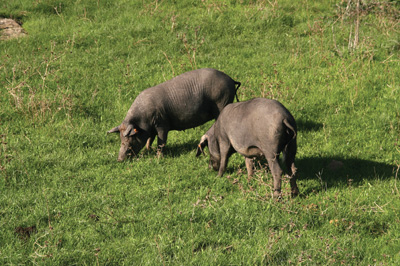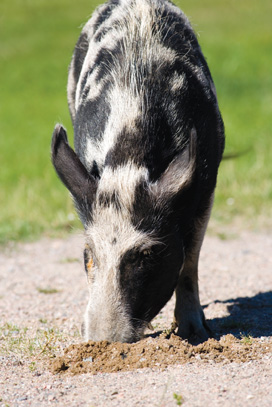
Agriculture and Agri-Food Canada’s
(AAFC) Atlantic Food and Horticulture Research Centre in Kentville,
N.S., is examining the use of grazing feeder pigs in three Annapolis
Valley organic apple orchards as part of a trial to control grass,
weeds and apple drops.
 Managing orchard floors with swine
Managing orchard floors with swine
There could be a future for swine in floor management in organic apple orchards.
Agriculture and Agri-Food Canada’s (AAFC) Atlantic Food and Horticulture Research Centre in Kentville, N.S., is examining the use of grazing feeder pigs in three Annapolis Valley organic apple orchards as part of a trial to control grass, weeds and apple drops.
The trail involves the AAFC plus three Valley organic growers, explains Lee-Ann Nunn, one of AAFC’s orchard management research team members.
The 2005 trial was funded under the Matching Investment Initiative program, with AAFC providing the research funds, the researchers and the 60 feeder pigs while the growers provided “in kind” support with test plots and some labour.
Noting there was little or no literature on the impact of grazing swine, Nunn says AAFC decided it might be worthwhile to look at using pigs as an organic orchard management tool.
“It was very exploratory in nature,” she says. “We really had no idea what would happen. We thought it might be a viable approach.”
The feeder pigs were placed on the plots for two, two-day trial periods at bloom-time in the spring and in the fall, post-harvest period, with 30 pigs per trial.
The pigs, both barrows and gilts, were first acclimatized inside an electrically fenced enclosure and fed organic rations before they were released for grazing in the orchard, explains Nunn.

They were grazed at two densities – 10 pigs per 500 square feet and 19 pigs per 260 square feet. However, it was observed that the pigs grazed down both plots equally.
The trial also had an ungrazed, unmown check plot. This plot provided a visible contrast to the grazed plots where the pigs did a good job of weed removal under the trees, says Nunn, adding that in the check plot, weeds were a problem under the orchard canopy.
With each grazing plot, it was observed that the pigs selected a preferred area to graze and another area to deposit manure. In the areas where the pigs grazed, regardless of the animal density in the plot, there was little grass left, although the pigs in the 19 per 260 square feet density consumed more grass. More research will have to be done to find the research for this difference, Nunn says.
Both post-harvest pig densities did a good job of cleaning up the drops in the trial orchards of Golden Russet and Macintosh, although the pigs did show preference to Golden Russet drops.
The research team did not test for groundwater contamination in the orchard plots by E. coli from the pig manure. Nunn says the pig manure contributed less nutrient loading than would be expected through a regular application of nitrogen to the orchard soil.
“This was just a preliminary investigation,” she emphasizes. “There are a lot more things in orchard grazing that have to be looked at.”
Nunn believes there is potential for more research into pig grazing, a technique she believes can easily be used for managing orchard floors in an organic system. The approach taken, however, would have to be different for a commercial organic operation, as the pigs would have to be rotated in the orchard every two days, Nunn adds.
Print this page